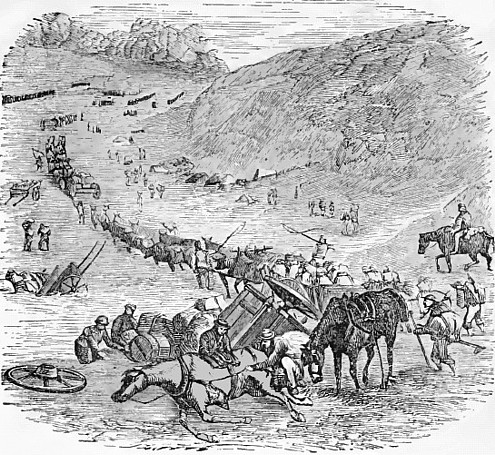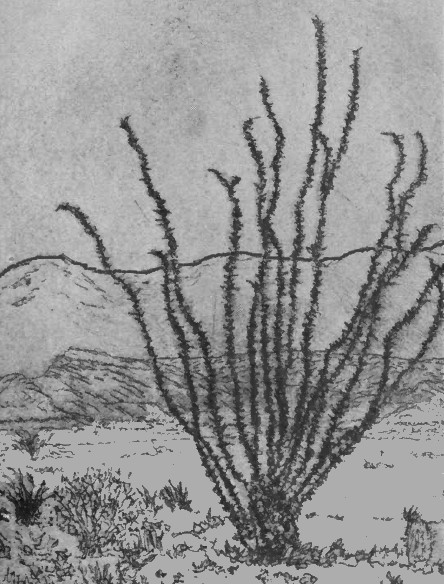NOGALES MINING DISTRICT
This area includes the region north of the international line and east from
the Nogales Wash, to Calabasas and
the Sonoita River on the north, the
eastern boundary being a line extending in that direction from a point where
the Santa Cruz River emerges from Mexico. It is about ten miles long and
seven in width. It is an elevated region, a spur extending northward from
the high divide between the Gila River basin and the coast of the Gulf of
California. The highest point is Mount Benedict, some three miles north from
Nogales, rising to an altitude of 4,500 feet; but the greater part of the
area has an elevation less than 4,000 feet above sea level.
The mineralized area in the district is upon the slopes of Mount Benedict, and chiefly they are native gold bearing, although silver, lead and tungsten ore have been found. The formation is quartz monzonite with intrusions of diorite, aplite, granite porphyry, etc., with which most of the mineral deposits are" associated. Near the Santa Cruz River there are placer beds from which some gold has been recovered. In the workings near the surface of some of the ledges the gold ore is said to have been very rich, but it was in small quantities. One shipment from the Dura Mine, sent to the Selby smelter, in California, is said to have yielded thirty-five ounces gold per ton; three carloads shipped in 1903 averaged $600 gold to the car. In 1895 a prospector named Lichliter shipped eighty tons which averaged $50 gold per ton. At a little depth the veins seem to pinch out, but the geological indications are that if followed down they will widen again, and become productive once more. So far as competent observers have given attention the ore occurrences are in lenticular form, and the surface openings were the lower sections of a series of lenses that had been cut down with erosion of the surrounding region. The principal properties are the Dura, Uncle Sam, Lion, Columbia, Float Gold and Reagan Mines. Near Guevavi, the site of one of the old Jesuit Missions, described hereinbefore, the Float Gold Amalgamating Company has a small stamp mill that was operated with considerable success in 1913. In the Reagan property there has been developed a deposit of wolframite and scheelite a shipment of which ores yielded about 50 per cent tungsten acid.
PATAGONIA DISTRICT
This district is adjacent to the Nogales District on the east, and crosses
the southern part of the Patagonia Mountains. The east and west width is
about twelve miles and it extends northward from the Mexican border about
eight miles. In elevation the mountains average about 5,500 feet, and the
highest peaks reach 7,000 feet. They are precipitous, rugged and sparcely
timbered with scrub oaks and juniper trees. As classified by geologists, the
rock formations include Mesozoic
limestone,
quartzite, shale, etc., with intrusions of quartz monzonite
(classified generally as syenite or granite), granite porphyry, diorite,
etc., sedimentary Mesozoic rocks consisting of shales and arenaceous
limestones ; Tertiary
rhyolite; and gravels and wash. As a rule mineralization occurs in
or is associated with the intrusive rocks; but at Duquesne and Washington
Camp they are a result chiefly of contact-metamorphic action. The mineral
deposits occur in a broad belt about six miles in width extending across the
district in a northwesterly direction, following the trend of the mountain
chain.
The district includes about forty promising groups of mines and mining camps, while the number of good claims and prospects runs up into the hundreds. Some of them are good producers now, and many have great records of production in former years. Among them may be mentioned the mines at Duquesne and Washington Camp, the Four Metals properties of the Red Mountain Copper Company, the Mowry Mines, Gross Group, Morning Glory, Old Soldier, Good View Mines (formerly Buena Vista), Santo Nino, Proto Group, Gladstone Mines, National Havelena, Creston, Skibo Development Company's properties, Golden Rose, Providencia, and many more.
MOWRY MINES
These properties are located on the east side of the Patagonia Mountains,
about four miles north from Washington Camp. They are distinctively lead and
silver ore producers, and have been worked to a depth of 500
feet. There are about 12,000 feet of underground workings, and a large and
effective machinery equipment consisting of a smelting furnace, hoists, etc.
Unfortunately a concentrating mill that was a part of the plant was
destroyed by fire several years ago. Litigation and internal difficulties in
the Santa Cruz Mines, Smelter & Transportation Company, which owned and
operated the mines (also the Alto Mines in the Santa Rita Mountains) have
caused suspension of operations through several years. Tradition says that
the Mowry was worked by the Jesuits during antigua times, but there is no
record of the operation. The authentic account of early operation antedates
the Civil War by two years, when Lieutenant Sylvester Mowry, U. S. A.,
commenced operation of the property and continued working about four years,
erecting a reduction plant and shipping lead-silver bullion and high-grade
ores to the value of about $1,500,000. This has been mentioned on a
preceding page. The formation is a fault contact between limestone and
quartz monzonite, and the ore bodies are to a great extent replacement in
the limestone. The ores are highly argentiferous lead combinations, and they
have run high in values. In the vicinity of Mowry are the Skibo, Cunningham,
Endless Chain, Bullwhacker, Olive and other good properties. The Olive was a
shipper of high-grade ores in the early 1870's.
The four metals mines are located about three miles southwest of Mowry, on the west side of the main crest of the Patagonia Mountains, is one of the properties mentioned earlier in this account as a remarkable presentation of a large, low grade copper deposit. This location will pay handsomely if worked on an extensive scale, with a great reduction plant, automatic in operation, handling low grade copper ore in quantity. It has been explored by a series of tunnels, three in number, with their various drifts, crosscuts, winzes, etc., aggregating more than a mile of work, proving to a depth of 600 feet below the croppings an extensive ore body that has been penetrated several hundred feet in all directions without reaching the utmost limits. There is in the gulch below a fourth tunnel site which will be developed shortly, giving a couple hundred feet more of "backs." Below that development will have to be by winzes, and there is no doubt that with the water level reached the character of the ores will change to copper sulfides, and very likely it will be found higher in grade. In fact, present development shows more copper in the ore in the lowest tunnel than in that in either of the others, and between those two the same rule prevails. The copper bearing rock is a rhyolitic porphyry, ground and crushed, with highly comminuted particles of chalcocite, chalcopyrite and pyrite disseminated throughout the mass. It is very friable, easily pulverized and concentrated, the concentrates going about one ton from sixteen tons of ore. As the rock in the lowest tunnel goes about 3 per cent copper, it shows that concentration will give a high-grade product. The Red Mountain Copper Company, owning and operating the property, is working conservatively, exploring the ore body and demonstrating daily its greater size and capacity for production, until such time as the need for a great reduction plant is proved, when one will be provided.
BUENA VISTA MINES
These are owned and operated by the Good View Mining Company, and lie a
couple of miles west from the Four Metals property, and they have entered
recently the list of producers, a small concentrating plant having been
installed to reduce the ores to concentrates. The mine is opened by tunnels,
on a ledge about four feet in width with a pay streak of high grade
chalcopyrite eighteen to twenty-four inches in width, that is very rich in
copper. A good deal of the ore has been shipped, with good results. The
concentrator will effect a saving in transportation. In this same vicinity
are the Providencia, G. L. & C. group, Shannon group, Proto Mines,
Gladstone, Old Soldier, Creston, National and many more good claims and
promising prospects. Capital and development are all that are needed to
place them in the list of permanent and profitable producers. Upon the east
side of the Patagonia Mountains.
Return
to The Arizona Page:
Arizona Gold Rush Mining History



